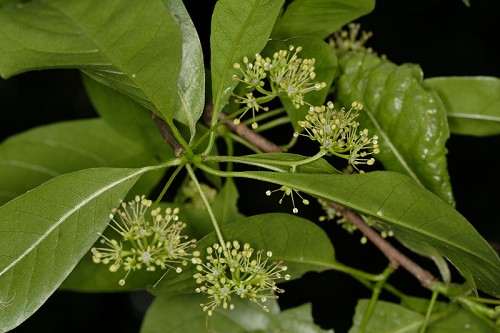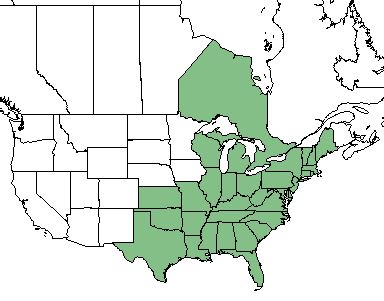Difference between revisions of "Nyssa sylvatica"
(→Taxonomic Notes) |
|||
| Line 19: | Line 19: | ||
}} | }} | ||
==Taxonomic Notes== | ==Taxonomic Notes== | ||
| − | Synonyms: | + | Synonyms: ''N/ sylvatica'' var. ''dilatata'' Fernald; ''N. sylvatica'' var. ''caroliniana'' (Poiret) Fernald |
Varieties: none | Varieties: none | ||
Revision as of 17:04, 27 June 2018
Common name: blackgum [1], sour gum [2], pepperidge [2]
| Nyssa sylvatica | |
|---|---|

| |
| Photo by John Gwaltney at the Southeasten Flora Database | |
| Scientific classification | |
| Kingdom: | Plantae |
| Division: | Magnoliophyta - Flowering plants |
| Class: | Magnoliopsida - Dicots |
| Order: | Cornales |
| Family: | Cornaceae |
| Genus: | Nyssa |
| Species: | N. sylvatica |
| Binomial name | |
| Nyssa sylvatica Marshall | |

| |
| Natural range of Nyssa sylvatica from USDA NRCS Plants Database. | |
Contents
Taxonomic Notes
Synonyms: N/ sylvatica var. dilatata Fernald; N. sylvatica var. caroliniana (Poiret) Fernald
Varieties: none
Description
N. sylvatica is a perennial tree of the Cornaceae family native to North America and Canada. [1]
Distribution
N. sylvatica is found in the southeastern corner of the United States from Texas to Maine, as well as the Ontario region of Canada. [1]
Ecology
Habitat
N. sylvatica proliferates in dry or mesic upland forests, less commonly in bottomlands, pine savannas, or upland depressions, where occasionally inundated briefly. [2] Specimens have been collected from residential areas, upland open woodland, mixed upland hardwoods, floodplain of creek, mesic wooded bluff, flatwoods, shores of lake, river floodplain, live oak stand of cypress depression, edge of small pond, slash pine flatwoods, wet hammock, cypress-gum pond, and pine woodland. [3]
Phenology
N. sylvatica flowers February-May. [4] It is also a relatively shade-tolerant species. [5]
Fire ecology
N. sylvatica is not fire resistant and has low fire tolerance. [1]
Use by animals
N. sylvatica has medium palatability tp browsing animals. [1]
Conservation and Management
Cultivation and restoration
Photo Gallery
References and notes
- ↑ 1.0 1.1 1.2 1.3 1.4 USDA Plant Database https://plants.usda.gov/core/profile?symbol=NYSY
- ↑ 2.0 2.1 2.2 Weakley, A. S. (2015). Flora of the Southern and Mid-Atlantic States. Chapel Hill, NC, University of North Carolina Herbarium.
- ↑ URL: http://herbarium.bio.fsu.edu. Last accessed: June 2018. Collectors: Loran C. Anderson, R.K. Godfrey, Angus Gholson, Wilson Baker, Patricia Elliot, A.F. Clewell, E. Tyson, E.A. Hebb, H. Kurz, Richard Mitchell, D. B. Ward, W.G. D'Arcy, C. Monk, H. Larry Stripling, Elmar Prichard, R. Komarek, R. Jean, Kevin Oakes, Cecil Slaughter, Marc Minno, T. MacClendon, K. MacClendon, Tom Gilpin, William Platt, Richard Carter, W. Baker, Sidney McDaniel, Andre Clewell, Walter S. Judd, Bob Simmons, Dana Griffin, Bruce Hansen, JoAnn Hansen, R.F. Doren, Gwynn Ramsey, E.S. FOrd, P.L Redfearn, Richard Houk, William Lindsey, R. Kral, Robert Lazor, R. A> Norris, K. Craddock Burks, K.M. Meyer. States and counties: Florida (Liberty, Leon, Walton, Suwannee, Okaloosa, Wakulla, Jefferson, Jackson, Gadsden, Columbia, Bay, Alachua, Lake, Baker, Calhoun, Osceola, Clay, Washington, Dixie, Flagler, Franklin, Madison, St. Johns, Taylor, Volusia) North Carolina (Bladen) Georgia (Grady, Thomas, Grady) Tennessee (Macon)
- ↑ PanFlora Author: Gil Nelson URL: http://www.gilnelson.com/PanFlora/ Date Accessed: 5/24/18
- ↑ Albrecht, M. A. and B. C. McCarthy (2006). "Effects of prescribed fire and thinning on tree recruitment patterns in central hardwood forests." Forest Ecology and Management 226(1-3): 88-103.